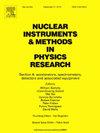Monochromatization interaction region optics design for direct s-channel Higgs production at FCC-ee
IF 1.5
3区 物理与天体物理
Q3 INSTRUMENTS & INSTRUMENTATION
Nuclear Instruments & Methods in Physics Research Section A-accelerators Spectrometers Detectors and Associated Equipment
Pub Date : 2025-01-29
DOI:10.1016/j.nima.2025.170268
引用次数: 0
Abstract
The FCC-ee offers the potential to measure the electron Yukawa coupling via direct s-channel Higgs production, , at a centre-of-mass (CM) energy of ∼125 GeV. This measurement is significantly facilitated if the CM energy spread of collisions can be reduced to a level comparable to the natural width of the Higgs boson, 4.1 MeV, without substantial loss in luminosity. Achieving this reduction in collision-energy spread is possible through the “monochromatization” concept. The basic idea is to create opposite correlations between spatial position and energy deviation within the colliding beams, which can be accomplished in beam optics by introducing a nonzero dispersion function with opposite signs for the two beams at the interaction point. Since the first proposal in 2016, the implementation of monochromatization at the FCC-ee has been continuously improved, starting from preliminary parametric studies. In this paper, we present a detailed study of the interaction region optics design for this newly proposed collision mode, exploring different potential configurations and their implementation in the FCC-ee global lattice, along with beam dynamics simulations and performance evaluations including the impact of “beamstrahlung.”
求助全文
约1分钟内获得全文
求助全文
来源期刊
CiteScore
3.20
自引率
21.40%
发文量
787
审稿时长
1 months
期刊介绍:
Section A of Nuclear Instruments and Methods in Physics Research publishes papers on design, manufacturing and performance of scientific instruments with an emphasis on large scale facilities. This includes the development of particle accelerators, ion sources, beam transport systems and target arrangements as well as the use of secondary phenomena such as synchrotron radiation and free electron lasers. It also includes all types of instrumentation for the detection and spectrometry of radiations from high energy processes and nuclear decays, as well as instrumentation for experiments at nuclear reactors. Specialized electronics for nuclear and other types of spectrometry as well as computerization of measurements and control systems in this area also find their place in the A section.
Theoretical as well as experimental papers are accepted.

 求助内容:
求助内容: 应助结果提醒方式:
应助结果提醒方式:


